Multi-Criteria Optimization of Mechanized Earth Processes and Its Impact on Economic and Environmental Sustainability
Abstract
:1. Introduction
2. Analysis of Factors and Machines Useful for Earth Processes
- Bulk soils taken by a shovel or loader;
- Bulk soils disconnected by a spade or loader;
- Pit soils disconnected by a picker, excavator;
- Crumbly soils disconnected by a wedge, excavator;
- Easy demolition consolidated soils disconnected by a ripper, large excavator, demolitions;
- Hard demolition consolidated soils disconnected by a hard ripper, demolitions;
- Very hard demolition consolidated soils disconnected by demolitions.
3. Scientific Methods Used
Multi-Criteria Optimization Method
- Each parameter is assigned a different severity expressed by the weight of the parameter;
- Deterioration of any parameter must lead to an increase in the value of the multi-optimization indicator;
- The indicator of optimization of individual parameters must be implemented in such a way as to eliminate the influence of the choice of units;
- The values of the optimization indicator of individual parameters should not grow above all limits (the resulting multi-optimization indicator will not be sensitive to the choice of weighting factors);
- We choose the value of the optimization indicator of individual parameters so that the best variant has the lowest value of this indicator (performance and productivity-reciprocal values).
- Definition of optimization indicators:
- 1.1
- Time indicator—TI (i):for i = 1 …. n, where:TI (i)—time indicator;Ti—total duration of the “i”th machine’s work;n—number of machines.
- 1.2
- Energy indicator—EI (i):for i = 1 … n, where:EI (i)—energy indicator;Ei—machine energy consumption;n—number of machines.
- 1.3
- Cost indicator—CI (i):for i = 1 … n, where:CI (i)—cost indicator;Ci—total cost of the “i”th machine´s work;n—number of machines.
- Definition of weighting factors:In our paper, we applied these weighting factors:
- 2.1.
- Weighting factor of time—WT as a percentage;
- 2.2.
- Weighting factor of energy—WE as a percentage;
- 2.3.
- Weighting factor of cost—WC as a percentage.
The sum of the weighting factors is equal to 100%. - Definition of multi-criteria optimization indicator—IMO(i):TI (i)—Time indicator;EI (i)—Energy indicator;CI (i)—Cost indicator;WT—Weighting factor of time (%);WE—Weighting factor of energy (%);WC—Weighting factor of cost (%).Note: the sum of the weighting factors is equal to 100%.
- The best variant (BV) of the machine set is determined by this formula:for i = 1 … n, where:IMOi—multi-criteria optimization indicator of “i”th machine.This method was applied in our paper in the model example.
4. The Proposal of the Machine Selection Optimizing (MSO) Method for Earth Processes Using Multi-Criteria Optimization with Software Support
- Definition of the construction problem and the final product of the construction processes:Description of activities: This phase includes the key definition of the construction problem and final product of mechanized earth processes and the definition of all important input data.
- Proposal of suitable machines or machines groups:Description of activities: In this phase, the main activity is the proposal of suitable machines for a given type of construction works. The criterion (the aspect of quality) is the usefulness of the machines to provide the defined earth product. Basic processes at this step are the analysis of the earth process and earth product; proposal of useful machines for the defined earth product; the selection of all necessary input data concerning the machines including information about technical parameters, cost, fuel consumption, etc. The output of this step is machines useful to realize the earth product.
- Assessment of machines in terms of required time:Description of activities: At this phase, all the proposed machines or machine groups are evaluated according to the time criterion. The first step is calculating the production rates of all proposed and useful machines, and then the duration of the process is calculated. Time is one of the key requirements of most investors. Basic processes at this step are the creation of a model of mechanized earth processes; the proposal of possible variants of machines for defined earth processes; the proposal of mathematical variables and creation of mathematical models for calculating the duration of mechanized earth processes; software calculation of the duration of work by selected machines; comparing selected machine variants to the time of work required.The output of this step is machines that fulfill the time requirement.
- Assessment of machines in terms of additional optimizing criteria:Description of activities: This phase includes all machines, that fulfill the time criterion evaluated according to additional optimizing criteria, for example, cost or energy aspects). Minimizing cost and the consumption of fuel of machines are very serious requirements of investors and the construction process suppliers. Basic processes at this step are the definition of mathematic variables concerning the optimization criteria (cost, energy); creation of mathematical models for calculation cost and energy consumption in the defined earth processes; software calculation of cost and energy consumption by the selected machines; comparing selected machine variants to cost and energy consumption results (the output from software). The output of this step and the optimal solution is the optimal machines from the point of cost and fuel consumption.The output of this step is a machine with minimal costs and energy consumption.
5. Application and Verification of This Optimal Method into a Model Example of Surface Excavation
6. Multi-Criteria Optimization of Mechanized Earth Processes
7. Conclusions
Author Contributions
Funding
Institutional Review Board Statement
Informed Consent Statement
Data Availability Statement
Conflicts of Interest
References
- Zhang, H. Multi-objective simulation-optimization for earthmoving operations. Autom. Constr. 2008, 18, 79–86. [Google Scholar] [CrossRef]
- Martinez, J.C. STROBOSCOPE: State and Resource Based Simulation of Construction Operations. Ph.D. Thesis, University of Michigan, Ann Arbor, MI, USA, 1996. [Google Scholar]
- Martinez, J. Earthmover-Simulation Tool for Earthwork Planning. In Proceedings of the 1998 Winter Simulation Conference, Washington, DC, USA, 13–16 December 1998; pp. 1263–1271. [Google Scholar] [CrossRef] [Green Version]
- Halphin, D.W. CYCLONE: A method for modeling job site processes. J. Constr. Div. 1977, 103, 489–499. [Google Scholar] [CrossRef]
- Shi, J.; AbouRizk, S. An Automated modeling System for Simulating Earthmoving Operations. J. Comput.-Aided Civ. Infrastruct. Eng. 1998, 13, 121–130. [Google Scholar] [CrossRef]
- Marzouk, M.; Moselhi, O. Multiobjective Optimization of Earthmoving Operations. J. Constr. Eng. Manag. 2004, 130, 105–113. [Google Scholar] [CrossRef]
- Mandičák, T.; Mésároš, P.; Spišáková, M. Impact of Information and Communication Technology on Sustainable Supply Chain and Cost Reducing of Waste Management in Slovak Construction. Sustainability 2021, 13, 7966. [Google Scholar] [CrossRef]
- Švajlenka, J.; Kozlovská, M.; Pošiváková, T. Analysis of Selected Building Constructions Used in Industrial Construction in Terms of Sustainability Benefits. Sustainability 2018, 10, 4394. [Google Scholar] [CrossRef] [Green Version]
- Švajlenka, J.; Kozlovská, M. Perception of User Criteria in the Context of Sustainability of Modern Methods of Construction Based on Wood. Sustainability 2018, 10, 116. [Google Scholar] [CrossRef] [Green Version]
- Kantová, R. Evaluation of Construction Site Noise to Allow the Optimisation of Construction Processes and Construction Machinery Selection. Appl. Sci. 2021, 11, 4389. [Google Scholar] [CrossRef]
- Zavadskas, E.K.; Šaparauskas, J.; Antucheviciene, J. Sustainability in Construction Engineering. Sustainability 2018, 10, 2236. [Google Scholar] [CrossRef] [Green Version]
- STN 73 3050 Zemné Práce. Všeobecné Ustanovenia. [Earth Works, Common Regulations]. Available online: https://normy.unms.sk/eshop/public/standard_detail.aspx?id=69207 (accessed on 12 October 2021).
- Gašparík, J.; Alamro, B.I.M. Optimization of Mechanized Earth Processes, 1st ed.; Tribun EU: Brno, Czech Republic, 2020; 132p. [Google Scholar]
- Roston, J.; Kziazek-Nowak, M.; Nowak, P.; Zawistowaki, J. Cash-Flow Schedules Optimization within Life Cycle Costing (LCC). Sustainability 2020, 12, 8201. [Google Scholar] [CrossRef]
- Zhang, J.; Zhong, D.; Zhao, M.; Yu, J.; Lv, F. An Optimization Model for Construction Stage and Zone Plans of Rockfill Dams Based on the Enhanced Whale Optimization Algorithm. Energies 2019, 12, 466. [Google Scholar] [CrossRef] [Green Version]
- Mickovski, S.B. Sustainable Geotechnics—Theory, Practice, and Applications. Sustainability 2021, 13, 5286. [Google Scholar] [CrossRef]
- Zavadskas, E.K.; Pamucar, D.; Željko Stevic, Ž.; Mardani, A. Multi-Criteria Decision-Making Techniques for Improvement Sustainability Engineering Processes. Symmetry 2020, 12, 986. [Google Scholar] [CrossRef]
- Erdogan, A.A.; Šaparauskas, J.; Turskis, Z. A Multi-Criteria Decision-Making Model to Choose the Best Option for Sustainable Construction Management. Sustainability 2019, 11, 2239. [Google Scholar] [CrossRef] [Green Version]
- Jin, H.; Mingyuan Zhang, M.; Yuan, Y. Analytic Network Process-Based Multi-Criteria Decision Approach and Sensitivity Analysis for Temporary Facility Layout Planning in Construction Projects. Appl. Sci. 2018, 8, 2434. [Google Scholar] [CrossRef] [Green Version]
- Rajagopalan, N.; Brancart, S.; De Regel, S.; Paduart, A.; de Temmerman, N.; Debacker, W. Multi-Criteria Decision Analysis Using Life Cycle Assessment and Life Cycle Costing in Circular Building Design: A Case Study for Wall Partitioning Systems in the Circular Retrofit Lab. Sustainability 2021, 13, 5124. [Google Scholar] [CrossRef]
- Pang, B.; Hao, F.; Park, D.S.; De Maio, C. A Multi-Criteria Multi-Cloud Service Composition in Mobile Edge Computing. Sustainability 2020, 12, 7661. [Google Scholar] [CrossRef]
- Anysz, H.; Nicał, A.; Stevic, Ž.; Grzegorzewski, M.; Sikora, K. Pareto Optimal Decisions in Multi-Criteria Decision Making Explained with Construction Cost Cases. Symmetry 2021, 13, 46. [Google Scholar] [CrossRef]
- Scraper CAT 621K. Available online: https://www.cat.com/en_US/products/new/equipment/wheel-tractor-scrapers/open-bowl-scrapers/18576136.html (accessed on 11 October 2021).
- Scraper Komatsu WS23S-1. Available online: https://www.ritchiespecs.com/model/komatsu-ws23s-1-motor-scraper (accessed on 11 October 2021).
- Scraper TEREX TS 14 G. Available online: https://www.ritchiespecs.com/model/terex-ts14g-motor-scraper (accessed on 11 October 2021).
- Scraper CAT 627G Auger. Available online: https://www.lectura-specs.com/en/model/construction-machinery/scrapers-caterpillar/627g-auger-998750 (accessed on 11 October 2021).
- Scraper Model CAT 637G. Available online: https://www.ritchiespecs.com/model/caterpillar-637g-motor-scraper (accessed on 11 October 2021).
- Scrapers Renting. Available online: https://www.rentalyard.com/listings/construction-equipment/for-rent/list/category/1054/scrapers (accessed on 2 October 2021).
- Lectura-Machine Databases. Available online: https://www.lectura-specs.com/en (accessed on 11 October 2021).



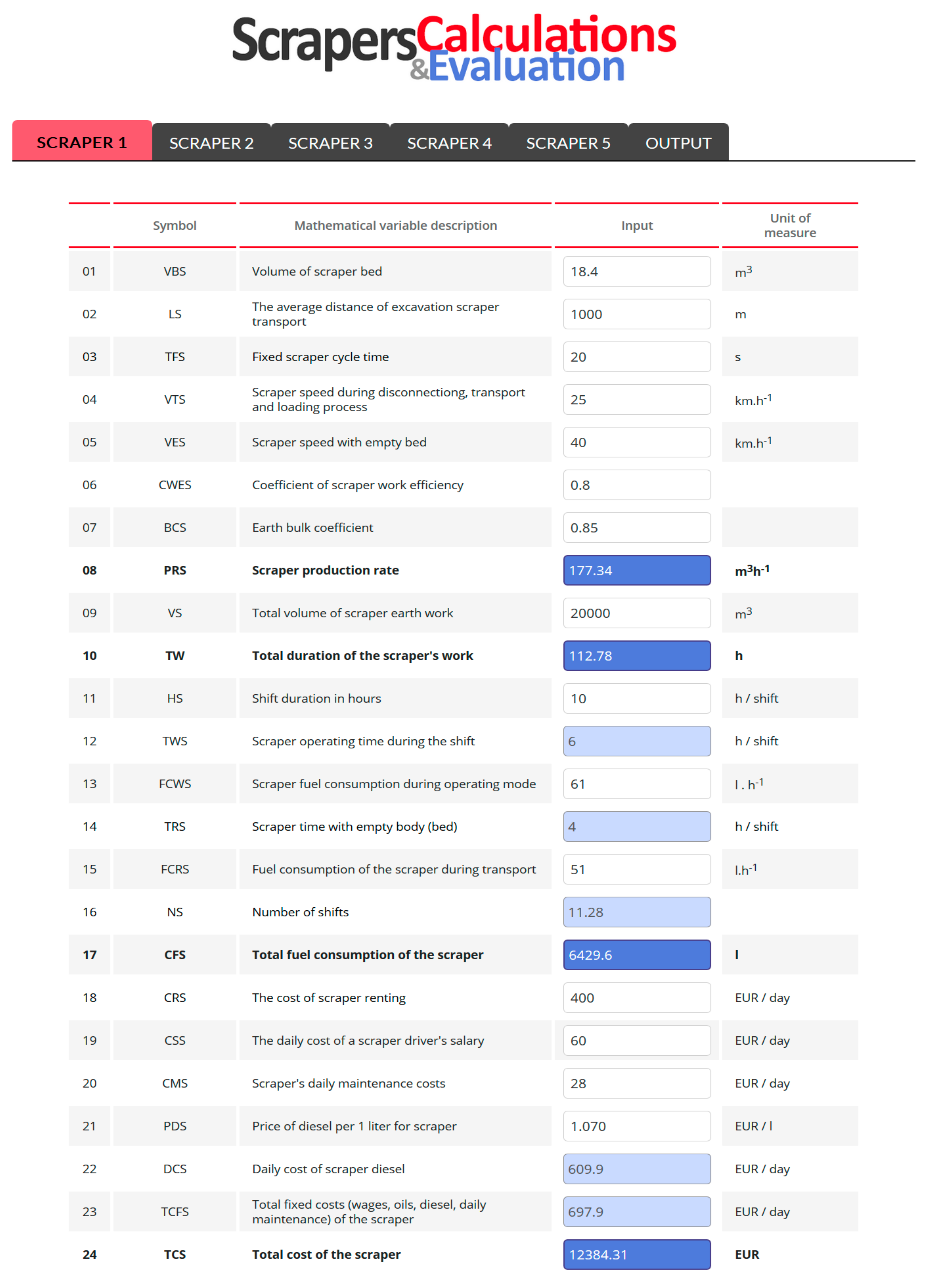
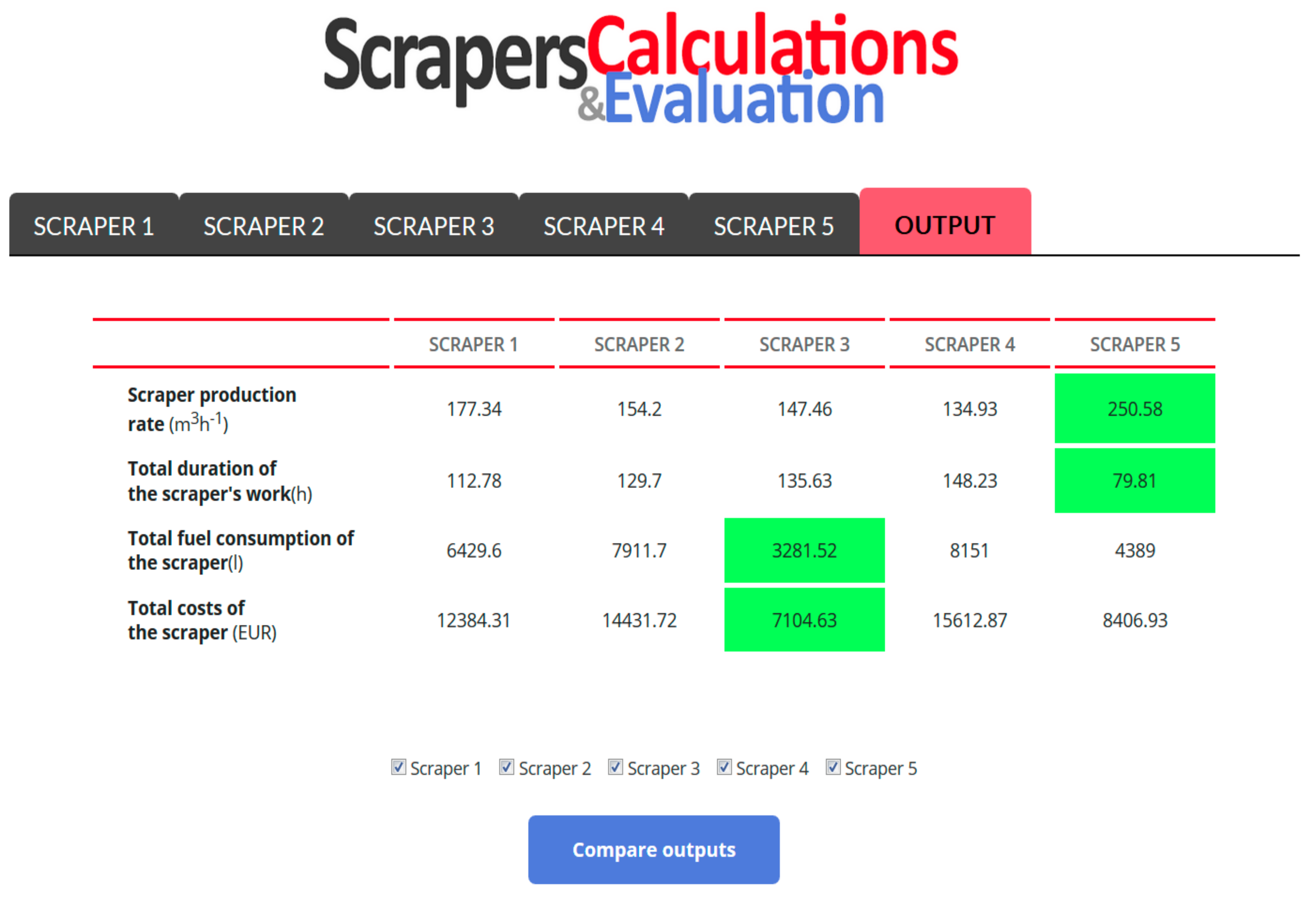

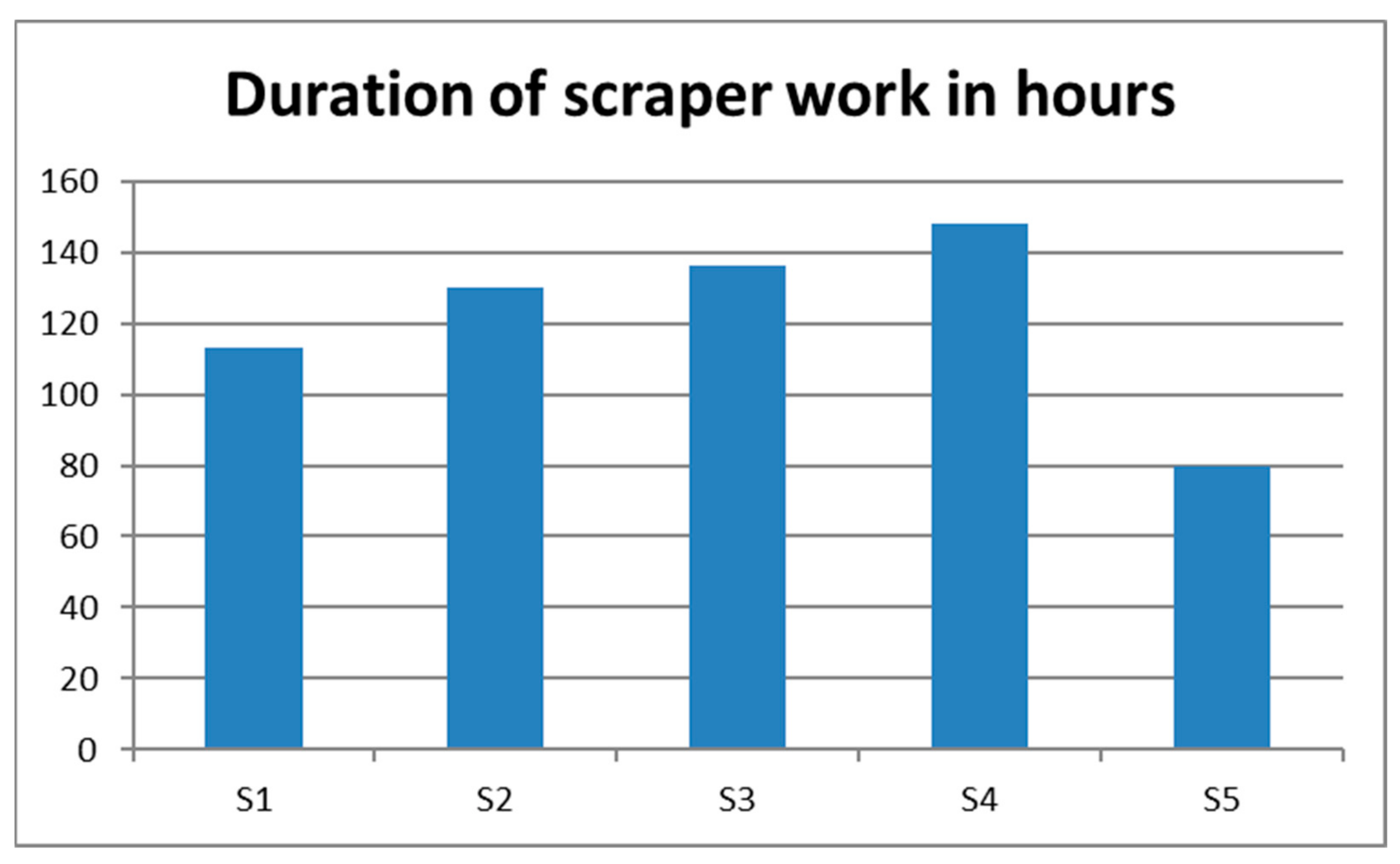

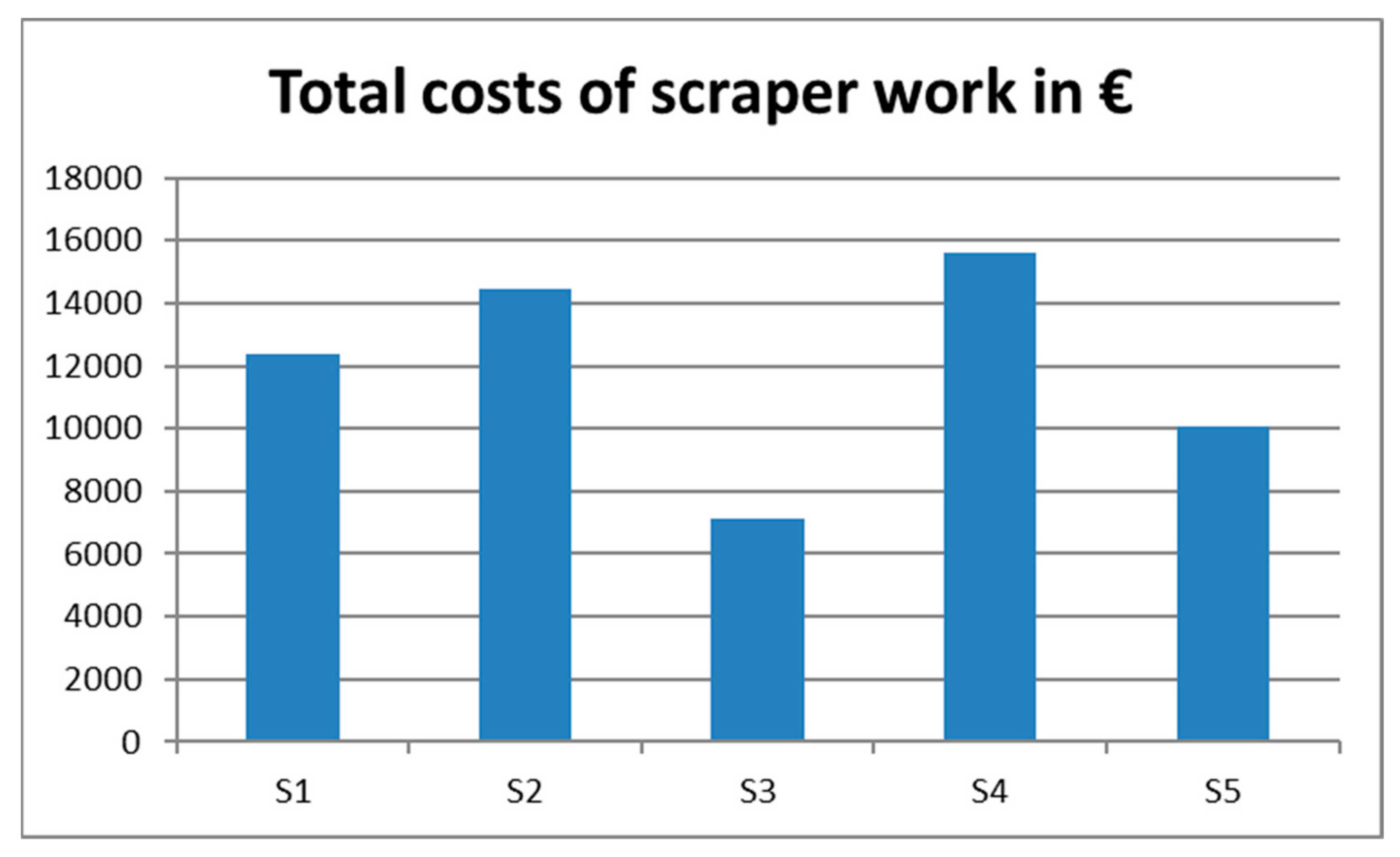
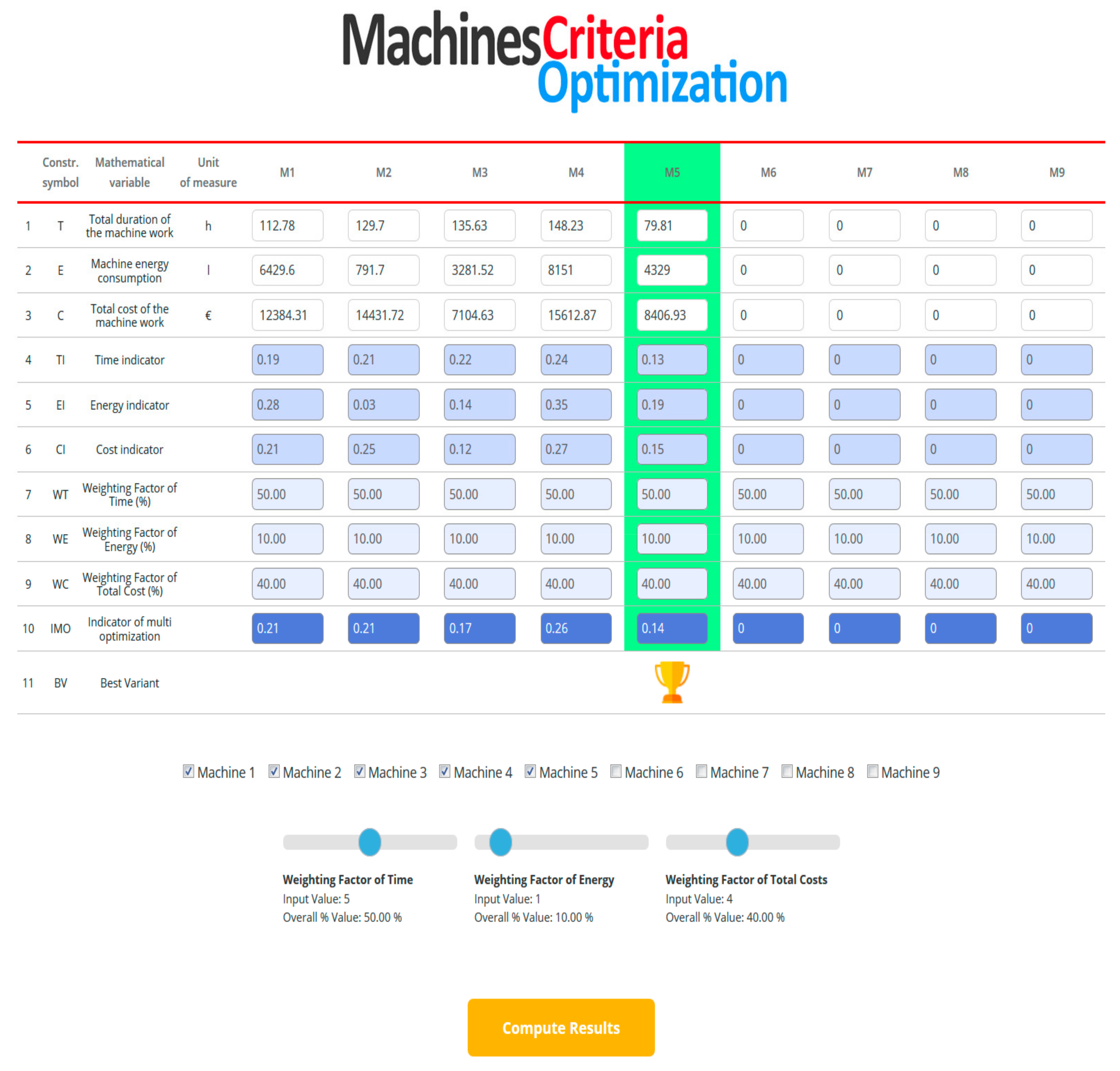
| Type of Machine | 1. | 2. | 3. | 4. | 5. | 6. | 7. | 8. | 9. | 10. | 11. | 12. | 13. |
|---|---|---|---|---|---|---|---|---|---|---|---|---|---|
| Conditions | |||||||||||||
| Characteristics of minerals, category of workability (Slovak standard STN 73 30 50) | |||||||||||||
| Watery earth | CS 1 | S 2 | S | CS | CS | ||||||||
| Modest workability, category No. 1–2 | S | S | S | S | S | S | S | S | S | S | S | S | S |
| Moderate workability, category No. 3–4 | S | S | CS | CS | S | S | S | CS | S | S | S | CS | CS |
| Hard workability, category No. 4–5 | S | S | CS | CS | CS | CS | S | S | |||||
| Modest workability, rock, category No. 5–6 | CS | CS | CS | ||||||||||
| Hard workability, rock, category No. 6–7 | CS | ||||||||||||
| Types of excavations | |||||||||||||
| Grading | CS | S | S | CS | CS | CS | S | S | S | S | CS | ||
| Construction pit | S | S | S | S | S | S | S | CS | |||||
| Dig products | S | S | S | S | CS | S | S | CS | |||||
| Construction furrow | S | S | S | S | |||||||||
| Construction shaft | S | ||||||||||||
| Surface grading, depth 0.5 m | S | CS | CS | CS | S | S | S | S | |||||
| Overburden | S | S | S | S | S | S | S | S | CS | S | |||
| Leveling, flattening | CS | CS | CS | CS | CS | S | S | CS | |||||
| Exact flattening | CS | CS | S | ||||||||||
| Sloping | S | CS | S | S | |||||||||
| Location of excavation area | |||||||||||||
| Open | S | S | S | S | S | S | S | S | S | S | S | S | S |
| Cramped | S | S | S | ||||||||||
| Under water | S | S | S | S | |||||||||
| Type of Machine | Convenient Transportation Distance in Meters |
|---|---|
| Crawler loader | 30–50 |
| Dozer | 60–100 |
| Wheel loader | 100–200 |
| Scraper | 300–1500 |
| Dump truck | More then 1000 |
| Production Operations | 01. | 02. | 03. | 04. | 05. | 06. | 07. | 08. | 09. |
|---|---|---|---|---|---|---|---|---|---|
| Types of Machines | |||||||||
| Excavators | + 1 | + | + | + | + | ||||
| Dozers | + | + | + | + | + | ||||
| Front-end loaders | + | + | + | + | + | + | |||
| Scrapers | + | + | + | + | + | ||||
| Graders | + | + | + | ||||||
| Dumpers | + | + | |||||||
| Dump trucks | + | + | |||||||
| Hydro mechanization | + | + | + | ||||||
| Compacting machines | + |
| N. | Construction Symbol | Software Symbol | Mathematical Variable | Unit of Measure | Mathematical Model | Note |
|---|---|---|---|---|---|---|
| 01. | VBS | VBS (i) | Volume of scraper bed | m3 | Input data | |
| 02. | LS | LS | The average distance of excavation scraper transport | m | Input data | |
| 03. | TFS | TFS (i) | Fixed scraper cycle time | s | Input data | |
| 04. | VTS | VTS (i) | Scraper speed during disconnecting, transport and loading processes | km/h−1 | Input data | |
| 05. | VES | VES (i) | Scraper speed with empty bed | km/h−1 | Input data | |
| 06. | CWES | CWES | Coefficient of scraper work efficiency | - | Input data | |
| 07. | BCS | BCS | Earth bulk coefficient | - | ||
| 08. | PRS | PRS (i) | Scraper production rate | m3 h−1 | PR = 1000.1.6.7/ (3/3.6 + 2/4 + 2/5) | PR = 1000.VBS.CWES.BCS/(TFS/3.6 + LS/VTS + LS/VES) |
| 09. | VS | VS | Total volume of scraper earthwork | m3 | Input data | |
| 10. | TW | TW (i) | Total duration of the scraper’s work | h | TW = 09/08 | TW = VS/PRS |
| 11. | HS | HS | Shift duration in hours | h/shift | Input data (8, 10, 12, 14, 16 h) | |
| 12. | TWS | TWS (i) | Scraper operating time during the shift | h/shift | TW = 0.6.11 | TW = 0.6.HS |
| 13. | FCWS | FCWS (i) | Scraper fuel consumption during operating mode | l.h−1 | Input data from scraper producer | |
| 14. | TRS | TRS (i) | Scraper time with empty body (bed) | h/shift | TW = 0.4.11 | TW = 0.4.HS |
| 15. | FCRS | FCRS (i) | Fuel consumption of the scraper during transport with an empty body (bed) | l.h−1 | Input data from scraper producer | |
| 16. | NS | NS | Number of shifts | shift | NS = 10/11 | NS = TW/HS |
| 17. | CFS | CFS (i) | Total fuel consumption of the scraper | l (liters of diesel) | CFS = 16(12.13 + 14.15) | CFS = NS(TWS.FCWS + TRS.FCRS) |
| 18. | CRS | CRS (i) | The cost of scraper renting | €/day | Input data from renting company | |
| 19. | CSS | CSS (i) | The daily cost of a scraper’s driver’s salary | EUR/day | Input data from construction company | |
| 20. | CMS | CMS (i) | Scraper´s daily maintenance costs | EUR/day | Input data from construction company | |
| 21. | PDS | PDS | Price of diesel per 1 L for scraper | EUR/l | Input data | |
| 22. | DCS | DCS (i) | Daily cost of scraper diesel | EUR/shift | DSF = (17/16).21 | DSF = (CFD/ NS).DCD |
| 23. | TCFS | TCFS (i) | Total fixed costs (wages, oils, diesel, daily maintenance) of the scraper | EUR/day | TCFD = 19 + 20 + 22 | TCFD = CSS + CMS + DCS |
| 24. | TCS | TCS (i) | Total cost of the scraper | EUR | TCS = (18 + 23)16 | TC = (CRS + TCFS)NS |
| N. | Construction Symbol | Software Symbol | Mathematical Variable | Unit of Measure | Mathematical Model | Mi (i = 1, 2, 3, …, 10) |
|---|---|---|---|---|---|---|
| 1. | T | T(i) | Total duration of the machine work | H | ||
| 2. | E | E(i) | Machine energy consumption | L (liters of diesel) | ||
| 3. | C | C(i) | Total cost of the machine work | EUR | ||
| 4. | TI | TI(i) | Time indicator | - | TI(i) = T(i)/SUM T(i) i = 1…10 | |
| 5. | EI | E(i) | Energy indicator | - | EI(i) = E(i)/SUM E(i) i = 1…10 | |
| 6. | CI | C(i) | Cost indicator | - | CI(i) = C(i)/SUM C(i) i = 1…10 | |
| 7. | WT | WT | Weighting factor of time | - | Input (0–100%) the same for all variants | |
| 8. | WE | WE | Weighting factor of energy | - | Input (0–100%) the same for all variants | |
| 9. | WC | WC | Weighting factor of total cost | - | Input (0–100%) the same for all variants | |
| 10. | IMO(i) | IMO(i) | Indicator of multi optimization | - | IMO(i) = (T(i).(WT(i) + E(i).WE + CI(i).WC).10−2 | |
| 11. | Best variant | BV | BV = min(IMO(i) i = 1, 2, 3, …, 10 11 = min(10) |
Publisher’s Note: MDPI stays neutral with regard to jurisdictional claims in published maps and institutional affiliations. |
© 2021 by the authors. Licensee MDPI, Basel, Switzerland. This article is an open access article distributed under the terms and conditions of the Creative Commons Attribution (CC BY) license (https://creativecommons.org/licenses/by/4.0/).
Share and Cite
Gašparík, J.; Motyčka, V.; Šťastný, P.; Szalayová, S. Multi-Criteria Optimization of Mechanized Earth Processes and Its Impact on Economic and Environmental Sustainability. Sustainability 2022, 14, 78. https://doi.org/10.3390/su14010078
Gašparík J, Motyčka V, Šťastný P, Szalayová S. Multi-Criteria Optimization of Mechanized Earth Processes and Its Impact on Economic and Environmental Sustainability. Sustainability. 2022; 14(1):78. https://doi.org/10.3390/su14010078
Chicago/Turabian StyleGašparík, Jozef, Vít Motyčka, Patrik Šťastný, and Sylvia Szalayová. 2022. "Multi-Criteria Optimization of Mechanized Earth Processes and Its Impact on Economic and Environmental Sustainability" Sustainability 14, no. 1: 78. https://doi.org/10.3390/su14010078






